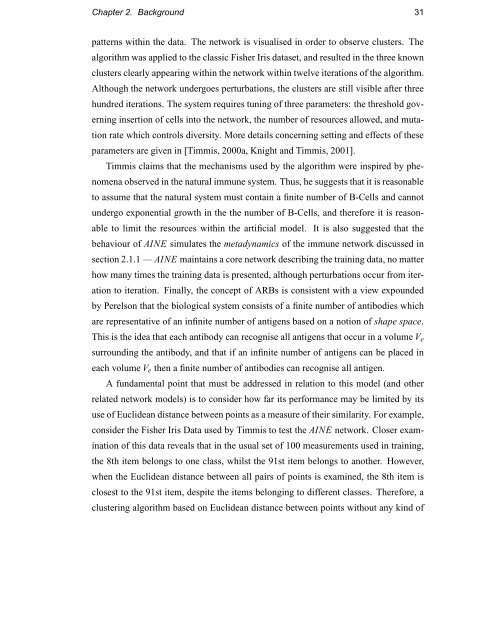Immunology as a Metaphor for Computational ... - Napier University
Immunology as a Metaphor for Computational ... - Napier University
Immunology as a Metaphor for Computational ... - Napier University
You also want an ePaper? Increase the reach of your titles
YUMPU automatically turns print PDFs into web optimized ePapers that Google loves.
Chapter 2. Background 31patterns within the data. The network is visualised in order to observe clusters. Thealgorithm w<strong>as</strong> applied to the cl<strong>as</strong>sic Fisher Iris dat<strong>as</strong>et, and resulted in the three knownclusters clearly appearing within the network within twelve iterations of the algorithm.Although the network undergoes perturbations, the clusters are still visible after threehundred iterations. The system requires tuning of three parameters: the threshold governinginsertion of cells into the network, the number of resources allowed, and mutationrate which controls diversity. More details concerning setting and effects of theseparameters are given in [Timmis, 2000a, Knight and Timmis, 2001].Timmis claims that the mechanisms used by the algorithm were inspired by phenomenaobserved in the natural immune system. Thus, he suggests that it is re<strong>as</strong>onableto <strong>as</strong>sume that the natural system must contain a finite number of B-Cells and cannotundergo exponential growth in the the number of B-Cells, and there<strong>for</strong>e it is re<strong>as</strong>onableto limit the resources within the artificial model. It is also suggested that thebehaviour of AINE simulates the metadynamics of the immune network discussed insection 2.1.1 — AINE maintains a core network describing the training data, no matterhow many times the training data is presented, although perturbations occur from iterationto iteration. Finally, the concept of ARBs is consistent with a view expoundedby Perelson that the biological system consists of a finite number of antibodies whichare representative of an infinite number of antigens b<strong>as</strong>ed on a notion of shape space.This is the idea that each antibody can recognise all antigens that occur in a volume V esurrounding the antibody, and that if an infinite number of antigens can be placed ineach volume V e then a finite number of antibodies can recognise all antigen.A fundamental point that must be addressed in relation to this model (and otherrelated network models) is to consider how far its per<strong>for</strong>mance may be limited by itsuse of Euclidean distance between points <strong>as</strong> a me<strong>as</strong>ure of their similarity. For example,consider the Fisher Iris Data used by Timmis to test the AINE network. Closer examinationof this data reveals that in the usual set of 100 me<strong>as</strong>urements used in training,the 8th item belongs to one cl<strong>as</strong>s, whilst the 91st item belongs to another. However,when the Euclidean distance between all pairs of points is examined, the 8th item isclosest to the 91st item, despite the items belonging to different cl<strong>as</strong>ses. There<strong>for</strong>e, aclustering algorithm b<strong>as</strong>ed on Euclidean distance between points without any kind of









![Unit 5. Switches and VLANs [PDF]](https://img.yumpu.com/34422504/1/184x260/unit-5-switches-and-vlans-pdf.jpg?quality=85)






